Anatomy of the Action Picture
January 2007
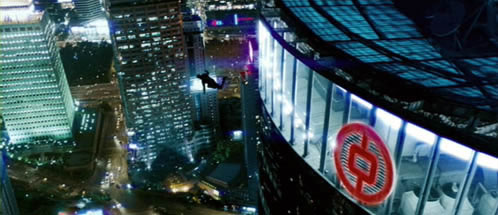
For a long
time Kristin Thompson and I have been interested in how films tell stories. We’re
fascinated by the principles that govern different storytelling traditions. For
the sake of simplicity, we’ve called the principles norms.
The
term implies a standard of craft competence, along with a dimension of collective
decision-making. Norms are preferred alternatives within a tradition. A norm
isn’t a single and inflexible law; it’s best seen as a roughly bounded set of
options. Within any cluster of norms, there are always different ways to do anything.
Film
scholars are often more interested in a concept’s connotations than in
its substantive content, so we occasionally hear objections to the term norm.
Doesn’t
the term suggest that we want to celebrate the normal and consign the non- or
abnormal to some sort of lower status? But we’re not suggesting that.
Both Thompson and I have studied and praised filmmakers who do things differently.
As historians we’re simply studying principles of storytelling, as they’ve
crystallized in norms that shape certain filmmaking trends. A researcher who
studies norms of height in a population isn’t implying that unusually tall
or short people are second-class citizens.
Sometimes
norms are just tacit, left to filmmakers to learn by example and intuition. My
studies of art cinema and Hong Kong cinema provide examples of such cases. But
sometimes filmmakers act in awareness of norms. More than other national cinemas,
Hollywood has developed some fairly explicit rules for how stories can be told
effectively. Moreover, a lot of Hollywood’s storytelling rules aim at achieving
a satisfying unity—the kind of plot we consider “tightly woven.”
This isn’t to say that the rules are detailed or rigorous; sometimes they’re
loose and vague. And some principles at work seem never to be spelled out as
rules.
You
can get the full account of this research program in The
Classical Hollywood Cinema, Storytelling in the New Hollywood, The Way Hollywood Tells It,
and various articles (a few of them on this site). Here are some of the questions
that guide us.
* Does actual Hollywood filmmaking follow the rules?
* By examining
the films, can we make vague guidelines more precise?
* What other
principles, even though they’re not stated explicitly, contribute to Hollywood
storymaking?
*
What are
the variations within norms, the alternatives permitted or encouraged within
a preferred set of practices?
Over the years, we’ve seen that our answers have
occasionally been confirmed by practicing filmmakers. Some manuals of screenwriting
have picked up on principles we’ve detected, turning them into explicit
rules. 1 1
Still, not
all film scholars agree with our conclusions. A common objection is that U.S.
mainstream movies aren’t as tightly unified as the rules, or as our books,
suggest. In particular, some scholars believe that the norms governing the contemporary
action film don’t
aim at unity. Action movies, many suggest, are loose assemblies of chases, fights,
explosions, stunts, and CGI effects, with little narrative coherence.
Granted,
unity will always be a more-or-less quality; some plots are more tightly woven
than others. Yet in The Way (pp. 104–114) I argue that if
we analyze action-adventure films, we find more unity than we might expect. Hollywood
action pictures are more tightly woven than they need to be, if all the makers
or the audience cared about was splashy spectacle. (I contrasted U.S. films with
Hong Kong ones, which favor much looser plotting.)
I didn’t
have the space in The Way to undertake a full analysis of any one action
film, but thanks to the Internets I offer a case study here, centering on Mission: Impossible: III.
When I saw it last summer, it struck me as a fairly tight action picture, and
rewatching it the other day, I started to count the ways.
Some norms
Here are five principles of storytelling that Thompson and I consider
crucial to most Hollywood films.
- Goal orientation.
The primary characters, protagonist
and antagonist, both want something, or several somethings. The story progression
is driven by characters’ efforts to attain goals and the way circumstances
alter those goals.
At the same
time, characters’ efforts to achieve goals create changes in the people
themselves. Sometimes they realize that they’re pursuing the wrong goal,
or that they must become worthy of the goal. In Storytelling, Kristin
discusses such possibilities in relation to Groundhog Day.
- The double plotline.
Typically the goals
govern least two lines of action, and at least one of these involves heterosexual
romantic love. A common pattern is a work/love pairing, where job problems affect
and are affected by romantic relationships. Recent examples: The Devil
Wears Prada, The Good Shepherd, The Prestige.
In some cases one plotline is subordinate to the other, but both are very often
present.
Here’s a case
of a norm that hasn’t, so far as I know, been articulated by the filmmakers
themselves. It seems simply to be taken for granted.
- Discrete part-structure.
The action revolves around goals:
defining them, modifying them, and achieving or not achieving them. Hollywood
films map the process onto several parts, each running 25–35 minutes (although
climax sections tend to be shorter). The running times of these parts don’t
count credit sequences unless they carry story information, so the final crawl
credits are typically not reckoned into the screen time of the film’s
narrative.
Since the
mid-1970s, screenwriters have talked a lot about the idea of the three-act structure.
In Storytelling in the New Hollywood (1999), Thompson refined this cluster
of rules. She suggested that we can analyze films more precisely by acknowledging
that not all films have three acts. In features running around two hours, we
typically find a four-part structure: Setup, Complicating Action, Development,
and Climax. Usually there’s a brief epilogue tacked on. Filmmakers working
in the three-act paradigm in effect split the second act into two stretches around
a midpoint.
Interestingly,
Thompson’s four-part structure is made explicit not only in manuals written
after her book, but in the very architecture of Shane Black’s Kiss Kiss
Bang Bang (2005).
The plot is split into four days, each given a title and each corresponding to
one of the parts she identifies. Black’s film ends with several epilogues;
this convention is mocked in Harry’s voice-over commentary, and one scene
is labeled, “Epilogue.”
- Planting causes for future effects.
Chekhov is said to have
remarked that in a play the gun on the wall in Act I should go off in Act III.
Likewise, Hollywood script carpentry lays in conditions that will prove important
later. But it’s not simply props that point forward:
more common are what we call dangling causes. An unresolved action is
presented near the end of one section that is picked up and pushed further in
a later section. Every scene will tend to contain unresolved issues that demand
settling further along.
- Deadlines.
It’s surprising how often
films in all genres set deadlines for the resolution of the plot. Screenwriters
call it the “ticking clock,” the time pressure that can rule
any portion of the film but that is virtually mandatory at the Climax.
In The Way Hollywood Tells It, I trace these
and other norms in detail through a particular example, Cameron Crowe’s Jerry
Maguire. What happens, though,
when the talented Mr. Cruise makes a full-throttle action picture?
To analyze
a film, I have to assume you’ve seen it, so beware: what follows is strewn
with spoilers.
Timings come from the 2-disc
DVD release.
Mission: Impossible: III
The Setup (00:32–31:34)
A prologue
establishes that the villain Owen Davian has captured Ethan Hunt and a woman
we’ll later realize is Ethan’s wife Julia. Davian demands to know
where the Rabbit’s
Foot is, and he threatens to shoot Julia if Ethan doesn’t say. As he fires,
a brief title credit bursts up, and the rest of the film unfolds as an extended
flashback.
You could
argue that, given director J. J. Abrams’ roots in TV, this prologue
functions in the manner of the teaser that samples a later part of tonight’s
episode. But today many films employ an enframed flashback structure. The plot
begins at a point of crisis and then whisks us back to show how things got to
this pass. The resolution of the opening scene is postponed until the Climax.
This strategy can be found at various points in the history of Hollywood, notably
in the 1940s. I talk about this trend in our blog.
After the
title credits, our protagonist Ethan is quickly assigned two goals. First, during
an engagement party, we learn that he and Julia Meade are planning to be married.
He seems to have happily settled into an Agency desk job, concealed as a boring
post in the Transportation Department.
Then he’s
yanked out of his home by a request from his colleague John Musgrave. Musgrave
asks Ethan to lead a covert team to find Lindsey Farris, a young agent whom Ethan
has mentored. She’s disappeared, and master criminal Owen Davian is thought
to be responsible.
So
the characteristic double plotline is established. Ethan wants a normal life
with the woman he loves. “Family’s
everything,” Musgrave remarks dryly. But Ethan also feels obliged to save
Lindsey, whom he had trained for combat and released for duty, perhaps prematurely.
So he’s forced to lie to Julia and pretend to go to a professional convention.
This sets up the work/romance tension we find so often in Hollywood films.
The
M:I team is assembled, with the returning Luther Stickell joined by new members
Declan and Zhen Lei. They and Ethan assault the Berlin factory where Lindsey
is kept prisoner. As she’s rescued, she tells Ethan she has information
for him but there’s
no time for her to impart it. Deadlines keep the pressure on. Escaping in a helicopter,
the team is chased by Damian’s minions, while Ethan discovers that Lindsey’s
brain is carrying an explosive capsule. He tries to halt it by stopping her heart
and using a defibrillator to bring her back, but they run out of time and she
dies.
At home Ethan
faces new problems. He’s still in shock from Lindsey’s death, which
makes Julia apprehensive.

At work, Ethan’s supervisor Brassel criticizes Musgrave
and Ethan, stating that his personal goal is to get Davian and they have thwarted
his efforts. The setup winds down when Ethan attends Lindsey’s funeral,
haunted by her question at the end of training: “Am I ready?”
Several
important items are planted in this opening section. All the major characters
are introduced. At the party we learn that Ethan can read lips, that Julia likes
adventure (she’s
gone skydiving and hung from a helicopter), and that New Zealand’s Lake
Wanaka is a memorable place for both of them. The threat of an embedded brain
capsule, the idea of letting someone die and be revived, and the fact that Julia
works at a hospital will all become important in later parts.
Just as important,
the action scene isn’t just a gratuitous set-piece. It’s central
to achieving Ethan’s goal, the rescue of Lindsey. The rescue’s outcome—her
death—motivates
his hatred for Davian and drives a wedge into his relationship with Julia. From
now on, as they say, it’s personal.
The Setup
runs about 31 minutes, with the key action of Lindsey’s death taking
place near the 25-minute mark, a sacred point in Hollywood dramaturgy. In addition,
first parts often have a turning point about halfway through: here, that’s
when Ethan meets his team (at about 13 minutes).
Mission: Impossible: III
The
Complicating Action (31:34–62:05)
Lindsey’s
funeral could simply end the movie. She’s beyond rescue, Davian has escaped,
and Ethan is at a dead end. But dangling causes keep things going. We already
glimpsed one in the factory assault, the urgent information that Lindsey started
to recount to Ethan. Now, at the end of the funeral scene, he gets a call from
a post office. A postcard is waiting for him. Dangling causes exemplify the famous
linearity of classical construction: one scene hooks into the next.
The Complicating
Action section serves to sharpen or alter the goals laid down in the Setup. The
postcard remains a dangling cause, because Luther has to decipher the microdot
that Lindsey has inserted under the stamp. In the meantime, Ethan learns from
the technie Benjy that Davian is seeking something called the Rabbit’s
Foot, “real
end-of-the-world stuff.” Davian is headed for the Vatican to make deals
with arms buyers, and Ethan resolves to pursue him, without telling anyone at
the Agency.
Meanwhile,
Ethan’s love affair with Julia is in jeopardy. Luther has warned that personal
relationships don’t mix with espionage, and his pessimism seems to be vindicated.
When Ethan makes new excuses to leave on a trip, Julia worries that he’s
hiding something important from her. To reassure her, he marries her in the hospital
where she works. Then it’s off to Rome to kidnap Davian, leading to an
even more elaborate set-piece. Using the twinning technology established in other M:I movies,
Ethan and the others snatch Davian.
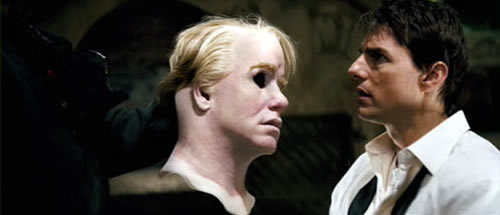
Again,
the action might seem to be at a standstill. Mission accomplished: The agency
boss Brassel congratulates Musgrave on Davian’s capture. But fresh dangling
causes emerge.
On the plane,
Ethan questions their captive. Davian resists, vowing to make whomever Ethan
cares about bleed—confirming Luther’s warning that secret-agent work
jeopardizes their loved ones. Further, Davian’s gloating about Lindsey’s
death drives Ethan into a rage. Davian’s a tough customer and may not reveal
what the Rabbit’s Foot
is. What if he should escape? He threatens to kill Ethan’s lover in front
of him, and we realize that this is no idle threat: the prologue showed him in
exactly this position. Somehow, we know, Davian will escape and turn the tables.
This
Complicating Action is another longish section (about 31 minutes), with several
new plants. Scenes with Julia establish that she’s a doctor and that their
relationship still doesn’t rest on full trust. Again, an elaborate action
scene contributes to the plot. Not only does it show Ethan achieving his goal,
it proves that, despite the death of Lindsey, he’s still a skilful agent.
This section also establishes an important minor character, Davian’s female
translator.
Mission: Impossible: III
Development
(62:05–93:56)
The Complicating Action often serves as a counter-setup,
reversing the first phase of the plot. In the setup of M:I:III, Ethan’s
mission failed, Lindsey died, and Davian got off free. In the Complicating Action,
circumstances were reversed: Ethan succeeded, Lindsey was avenged, and Davian
was taken in custody. What do Development sections do?
The Development
can reverse the overall circumstances, creating new goals. It can sustain the
situation. It can reveal backstory and deepen characterization. And it can simply
delay resolution. The Development of M:I:III does all of these things.
First,
some massive reversals. A convoy is carrying Davian to Washington. On the bridge
Luther finally cracks the microdot Lindsey had mailed Ethan. She reveals that
their boss Brassel is working in cahoots with Davian. At that instant a
paramilitary force attacks the bridge and in an explosive firefight Davian is
rescued. Ethan suffers a stunning setback, and not just from the concussive force
of the assault.
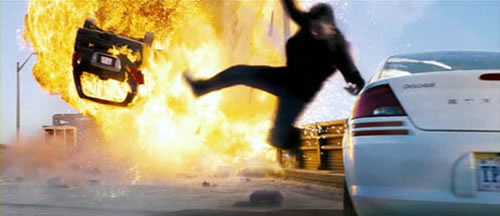
He races
to Julia’s hospital to protect her, but too late: she’s been seized.
As Ethan leaves the hospital, he’s called by Davian. “Julia’s
life for the Rabbit’s
Foot.” Davian gives him 48 hours to find it. A new goal has emerged, this
time with a precise deadline. At this moment Ethan is captured by his own agency
and is eventually immobilized, strapped to a gurney.
Ethan’s capture
blocks him from acting on Davian’s command, and the situation is prolonged,
delaying his progress toward rescuing Julia. The static situation is sustained
by Brassel’s
address to Ethan, one that seems to confirm Lindsey’s message. Talking
like the conventionally obsessed villain, Brassel vows that he will “bleed
on the flag” to get his way.
Again,
the action seems at an impasse. When Brassel leaves, Ethan’s contact Musgrave
visits him and seems to chide him. But he mouths something quite different, and
Ethan’s lip-reading skills are now put to use. Musgrave has intercepted
Davian’s
call, he says, and the Rabbit’s Foot is in Shanghai. Musgrave also gives
Ethan a weapon that enables him to escape from the Agency and head to China.
Ethan’s
new goal, that of getting the Rabbit’s Foot, dominates the rest of the
Development. From a structural standpoint, this goal is something of a delaying
tactic, since Ethan’s true goal is to rescue Julia. But this goal ratchets
up the work/love tension, since in grabbing the Rabbit’s Foot Ethan is
betraying his professional identity. His choice to save Julia reveals his character:
family is indeed everything. Ethan’s new goal also motivates another action
sequence, the incursion into a Shanghai skyscraper, and once more the pursuit
and stuntwork are driven by a deadline. “We have two hours before they
kill my wife.”
As the chase
in Shanghai concludes, Ethan calls Davian, who orders him to the city’s
train yard. Ethan informs Musgrave about the rendezvous, and suspense is increased
when Brassel questions Musgrave about the mission. Ethan leaves his team at the
Shanghai train yard, so he faces Davian alone. After a 31-minute Development,
the climactic confrontation is imminent.
Mission: Impossible: III
Climax
(93:56–116:19)
Picked
up in a stretch limo, Ethan is ordered to swallow the drink he’s given.
He passes out, dreaming of Julia. In a flash, we see him injected with the same
sort of explosive capsule that killed Lindsey. Now we return to the situation
presented in the prologue, with some repetition. Ethan is lashed to a chair facing
Julia and Davian. Once again Davian demands to know where the Rabbit’s
Foot is, once more Ethan frantically bargains with him, and once again Davian
threatens to shoot Julia, sitting bound and gagged across from Ethan.
Climax
sections, as you’d expect, show the culmination and outcome of the plotlines
running through the film. They also reveal information and clear up mysteries.
Climaxes tend to be shorter than other sections, as this one is. As a denouement
(literally, “untying”),
the Climax may contain a final surprise as well.
Davian’s confrontation
with Ethan is crosscut with the arrival of the rest of the Mission: Impossible
team in DC. They’re greeted at the airport by Brassel’s squad. This
scene seems to function as a red herring, reassuring us that Brassel is indeed
Davian’s mole.
It also deepens Ethan’s plight, now that his team can’t come to his
rescue.
Ethan doesn’t
know where the Rabbit’s Foot is, so Davian shoots Julia and leaves. Ethan
is shattered. (So are we, perhaps, because in the modern action picture even
people we care about may die; viz. The Bourne Supremacy.) After a long
pause, John Musgrave enters. “It’s complicated.”
The familiar
double-bluff of spy films locks in. Musgrave, not Brassel, is the mole. You could
argue that this twist was planted near the end of the Development, when Musgrave
turned away from Brassel and stared gravely offscreen as the camera lingered
on him—the classic shot of a Suspect.
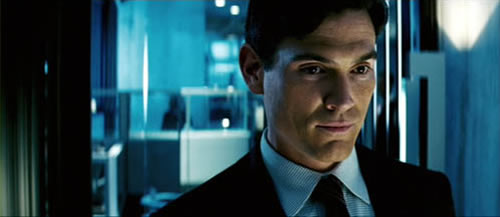
Now Musgrave
explains that the questioning of Ethan and the execution of “Julia” were
methods of guaranteeing that he brought the genuine Rabbit’s Foot. Musgrave
peels the mask off the victim to reveal it’s not Julia but rather Davian’s
translator from the Vatican sequence.
Musgrave’s
goal is to find out what was in Lindsey’s microdot message. In return Ethan
demands proof that Julia is alive, and the Lake Wanaka motif comes to fruition
as a way of identifying the voice on Musgrave’s phone. Ethan escapes and,
with the aid of Benjy on his cellphone, sprints to save Julia. As he fights his
way through Davian’s lair, the fatal capsule is triggered in his skull.
Ethan falters and Davian begins to beat him. Another deadline: “You have
maybe four minutes left.”
Staggering,
Ethan summons the strength to kill Davian, but to defuse the capsule, Julia must
kill and revive Ethan. She’s a doctor; there’s a chance she can pull
this off. As she’s trying to save him, another wave of gunmen assaults
her, and she puts them down with a forcefulness born of desperation. When Julia
shoots Musgrave, the Rabbit’s Foot rolls toward the camera, and now only
the romantic line of action needs resolution.
Julia’s purported
thirst for adventure pays off, and the parallel to Lindsey’s gunplay in
the Berlin factory is underscored.
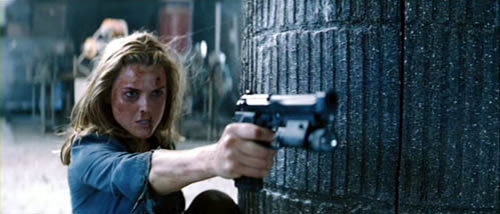
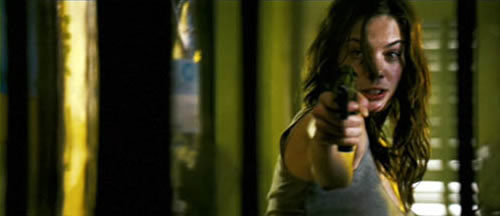
Lindsey was Ethan’s action partner, Julia his romantic partner, but under
the press of circumstance Julia has become both. Ethan comes back to life. “You
did that? Wow.”
Mission: Impossible: III
Epilogue (116:19–118:55)
The
film could end here, and a Hong Kong film might do so. But Hollywood films like
to wrap everything up with a scene or two assuring the audience that all is well.
Not just a happy ending, then, but an emphatic resolution. Call it an
epilogue.
First we reaffirm
that the romantic line of action is resolved. Outside Davian’s hideout
Julia and Ethan walk across a bridge and he promises to tell her everything.
He starts by describing the Impossible Mission Force, but she scoffs. The issue
of their marriage is settled when she adds, “You can trust me.”
Then
we settle the professional line of action. Back at HQ, Brassel tells Ethan about
a White House job that’s available, but Ethan demurs. He just wants a honeymoon.
The Rabbit’s Foot is revealed as a macguffin, a mere pretext; we never
learn what it really is. Julia is assimilated wholly into Ethan’s world
by meeting his entire team, including Benjy, before the couple leave. Now both
plotlines are resolved.
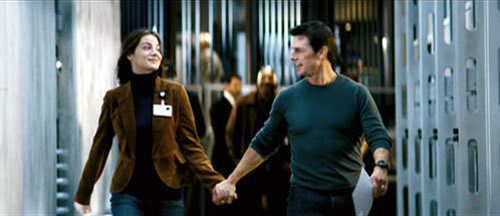
Implications
Clear and
simple in outline, the classical film’s dramaturgy can be manifested in
intricate and subtle ways. Like a well-made play, a film can fulfill principles
of unity clumsily or adroitly. I’d put M:I:III in the mid-range.
It’s
not as cannily intricate as Die Hard, and not as well directed
in my opinion (though there are some fine stretches of cutting and composition).
In all, the film is reasonably well-wrought for its purposes. The point I’m
proposing is that the action movie needn’t be considered a mindless splatter
of violent spectacle and CGI. It can have a cogent architecture.
There would
be a lot more to say about unifying principles in M:I:III, particularly
at the level of the scene and the links between scenes. My analysis has emphasized
overall narrative structure, not narration (the moment-by-moment flow of story
information) or the world of the narrative (the characters and their surroundings).
These aspects could be studied as well, but I wanted to make a prima facie case
for the unity of construction at work here.
FAQs
Q: People
go to see films like M:I:III for action and spectacle. They don’t care
about plot; it often bores them. By attending to story factors, don’t you deemphasize
the genre’s very reason for being?
A: First,
the distinction between action and story seems to me untenable. Story goals can
be fulfilled through action scenes, and even what is called spectacle. This happens
throughout M:I:III, in which the physical action furthers the overall
plot. Action sequences create goals (saving Lindsey), eliminate characters (e.g.,
Lindsey), redefine goals (Davian’s escape), and so on. Stories present
constantly changing circumstances, and action sequences alter situations as effectively
as conversation scenes do. As Murray Smith puts it, “The plot advances through spectacle.” 2 2
Of
course action scenes are central to the genre, so we should expect them to be
highlighted for special attention. The question is whether the action scenes
are integrated into a larger pattern. I hold that very often they are. But if
people don’t
care about plot, we ought to have a lot less plot than we do.
Try a thought
experiment. Most action films aren’t slam-bang action all the way through;
they consist mostly of conversations and suspense scenes. So imagine a two-hour
film containing 45 minutes of spectacular action. Why don’t filmmakers
simply release a movie containing only the action scenes? There are probably
several reasons, but one reason is that the film works better for audiences,
especially emotionally, when the plot ties the action scenes together. My analogy
in The Way
Hollywood Tells It is to the appeals of the star. Everybody likes stars,
but nobody pays $8 to watch Sandra Bullock and Keanu Reeves sitting on a sofa
together, Warhol-style, for 90 minutes. We like stars, but in stories; and stories
that move us.
Q: Action
fans often don’t rewatch the entire film on video. They go back and savor
explosions, then fast-forward through the talk. Doesn’t that show that
these movies are highly modular and episodic?
A: Fans do use home video to repurpose films to their tastes
and moods. But that can be done with any scenes we like, in any genre. If I’m
a big Antonioni fan, I might replay the last sequence of L’eclisse over
and over because it’s
so quintessentially Antonionian. No fireballs or gunfights there.
Moreover,
the fact that clips can be pulled out and enjoyed on their own doesn’t prove
anything about the unity of the overall movie. Ralph Vaughan Williams’ Fifth
Symphony is a highly unified piece, but I especially enjoy the last movement
and often play it in isolation, especially now that I have iTunes on my desktop.
Enjoying that passacaglia as a separate piece doesn’t reduce the unity of the
whole symphony one jot.
Q: You show
that the action scenes play causal roles in advancing M:I:III’s
plot. But they’re very long and elaborated, as in many action pictures.
If the film were as tightly unified as you say, shouldn’t they be shorter?
Isn’t
the sheer fact of their duration proof that they overwhelm narrative principles?
A:
Actually, a great many scenes of physical action depend on a basic narrative
principle: overcoming
obstacles. The action scenes in M:I:III are little stories in themselves.
Each one is governed by a goal, an effort to achieve it, a conflict with circumstances
that block achievement, a redeployment of efforts in light of the obstacle, and
so on….until the goal is definitely achieved or not. These mini-stories
often operate under a deadline as well.
In the opening
firefight of M:I:III, Ethan tries to find Lindsey in the factory. After
encountering some resistance, he does. Then he must get her out to the rest of
the team. After conquering some obstacles, he does. Then the team sets off in
a helicopter, but they’re pursued. Then they have to save her from the exploding
capsule, while also avoiding the villains’ chopper. At the end, one goal is achieved—they
escape—but the other isn’t: Lindsey dies.
If all that
isn’t narrative, what is?
The stretched-out
duration of action sequences, I submit, involves not one-off attractions for
their own sakes but micro-stories, short but twisting paths toward short-term
goals, quick adjustments to a fast-changing situation. The gunplay, the escapes,
the explosions, the bodies dangling from skyscrapers—all operate according
to fundamental narrative principles of conflict, struggle, suspense, and resolution.
Incidentally,
this consideration casts a new light on the previous Q and A. When fans replay
exciting escapes and fights, they’re not escaping narrative: they’re
immersing themselves in it.
I wish I’d
thought of this rejoinder in The Way Hollywood Tells It!
Q: Noting
down all these structural patterns and unifying strategies focuses on the film as
an object. What do these techniques do for viewers?
A: A great deal
of our response is generated by a film’s narration and its story world,
not simply structure, but we can at least say this: Structural unity of this
or any other sort is a way of achieving effects. Thrills become more
thrilling in a goal-oriented framework because then we care about who survives
the chase or the plunge off a building. Connective scenes become more enjoyable
when we spot recurring motifs or notice how characters are changing their beliefs
and character traits. We don’t always notice how the norms are shaping our response, but they
do so. That’s one reason the norms are worth studying.
Another, perhaps
more abstract reason is that by studying norms we can make film history more
intelligible. Norms of form and style come to be taken for granted by filmmakers,
audiences, and scholars. We can usefully bring them to light. By studying norms
as craft practices of filmmaking, we identify traditions and link the present
to the past in an enlightening way.
At the same
time, by studying norms as principles, rules, or rules of thumb, we become aware
of alternatives, including the creative choices that move away from tradition.
Sometimes we want to know why a film puzzles or intrigues or frustrates us, and
it’s often useful to trace those qualities to its refusal to play by the
rules. Perhaps the reason we find some “art films” frustrating is
that we can’t identify character goals or clear-cut lines of cause and
effect. (Have we internalized the Hollywood norms?) Studying norms of alternative
traditions can enable us not only to understand their principles of construction
but come to enjoy the distinctive experiences they offer.
Of course,
films that play by the Hollywood rules can be fun too—as I think M:I:III is.
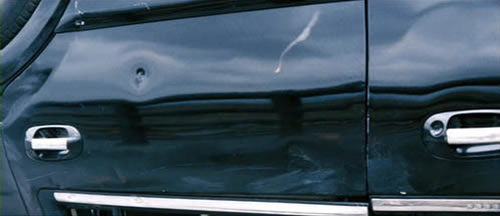
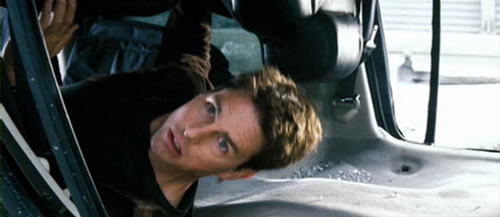
1 : See,
for instance, Paul Joseph Gulino, Screenwriting: The Sequence Approach (New
York: Continuum, 2004), 5-6, 12. Another example is the discussion of goals and
deadlines in Karl Iglesias, Writing for Emotional Impact (Livermore,
CA: Wingspan, 2005), 52, 100.
2 : Murray
Smith, “Theses
on the Philosophy of Hollywood History,” in Contemporary Hollywood
Cinema,
ed. Steve Neale and Murray Smith (New York: Routledge, 1998), 13.
|
|



